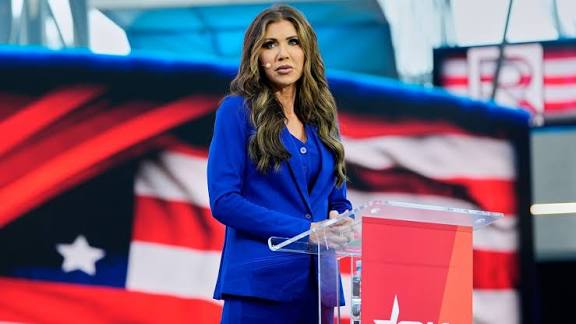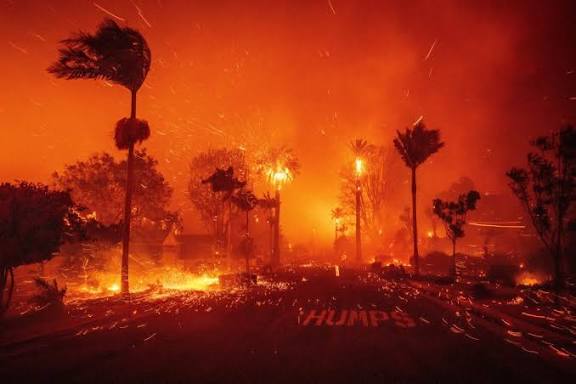Kristi Noem Blasts Mayorkas: Border Fiasco Explained

Christie Nom shed tears in the erstwhile Alejandro Mecorus on ‘Pod Force One’ to open the southern border. Today we will discuss about Kristi Noem Blasts Mayorkas: Border Fiasco Explained
Kristi Noem Blasts Mayorkas: Border Fiasco Explained
In mid-September 2025, U.S. Homeland Security Secretary Kristi Noem launched a sharp, public critique of her predecessor, Alejandro Mayorkas, accusing him of failing to secure the U.S. southern border, enabling surges in illegal migration, and presiding over what she calls a “fiasco” that endangered national safety. The clash is not merely political sparring; it reflects deep disagreements on immigration policy, enforcement, humanitarian responsibilities, and national security. To understand what Noem is claiming, what the evidence shows, and what the implications are, we must review the context, the main points, what’s true (or contested), and how this shapes U.S. policy going forward.
Background: Who’s Who and Recent Shifts

-
Alejandro Mayorkas served as Secretary of Homeland Security under President Joe Biden. His tenure was marked by extremely high levels of migration at the southern U.S. border, litigation over policies, political battles over immigration reform, and frequent attacks from Republicans who say the border was “open.”
-
Kristi Noem, previously Governor of South Dakota, became DHS Secretary under Donald Trump’s second administration. From Day 1 she has positioned herself as seeking to reverse many policies from the Biden era, stepping up enforcement, pushing for stricter controls, and being more outspoken in criticizing her predecessors.
-
The southern U.S. border (with Mexico) has for years been a flashpoint in U.S. politics: balancing between humanitarian concerns (asylum seekers, migrants in dire situations), legal obligations, and domestic political pressure to control unlawful entries, drug trafficking, human trafficking, etc.
-
Mayorkas faced political consequences: in February 2024, the House of Representatives voted to impeach him over allegations that he willfully ignored immigration laws and misled Congress about border security. But the Senate did not convict.
What Noem Is Saying
Noem’s critique has several core claims. Here are her main arguments, as drawn from recent interviews (especially the “Pod Force One” podcast) and statements:
-
Border was “opened” under Mayorkas
Noem says Mayorkas allowed massive numbers of migrants to cross or enter the U.S., including criminals, individuals on terrorist watchlists, and that lax policies contributed to this. She frames it as a failure to secure the homeland. -
Policies encouraged human & drug trafficking, child exploitation
She alleges that under previous administration policies, children went missing, trafficking occurred, and that some individuals reused migration routes or crossed multiple times with different groups of adults. She says authorities “watched” this happen. -
Morale & agency dysfunction
She argues that the Border Patrol and other agencies were demoralized under Mayorkas’s leadership, and that agents were falsely accused (e.g. of abuses) and not allowed to fully do their jobs. -
Criticism of legal tools used under Biden/Mayorkas
Noem has in the past promised to shut down the CBP One app (used to schedule legal entry appointments) and to end certain parole programs for migrants from certain countries. She has called previous policies “concierge services” for migrants. -
Questioning the moral & legal responsibility
She repeatedly asks: how did Mayorkas “sleep at night” given the vulnerable people affected, the children missing, the alleged failures. She frames these not just as policy failures but moral ones. -
Claims of improved outcomes since change in administration
Implicit in her remarks is that under her leadership things are being corrected: illegal crossings reduced, dangerous individuals removed, law enforcement being empowered, etc. Also, apologizjing to agents who were falsely accused in incidents such as the 2021 Del Rio “whipping” controversy.
What Does the Evidence Say?
Many of Noem’s claims are grounded in public data or major reporting—but some are contested, or lack full clarity. Below is what seems solid, what is uncertain, and points of disagreement.
| Claim | What is supported / likely | What is disputed or unclear |
|---|---|---|
| High volumes of border crossings under Mayorkas | Yes — Border encounters under the Biden-Mayorkas era reached historic levels (millions per year), suggesting pressure on the system. Reports show record numbers of migrants attempting to cross or seeking asylum. | How many of these were “illegal” versus asylum seekers under legal frameworks; how many were criminals; exact numbers on those on terror watch lists are often opaque. |
| Criminals, gang members, and individuals on terror lists | Some reports suggest border enforcement operations discovered people with criminal records, and occasionally people on watchlists, among migrants. Noem has cited such cases. | Scale matters: whether these are large proportions, or rare outliers. Also, “being flagged” doesn’t always mean active threat or allowed entry. |
| Children missing, trafficking, repeated crossings | There is reporting that sizable numbers of unaccompanied minors have crossed, been placed with sponsors, and that oversight has been criticized. Allegations of children being trafficked or exploited under weak supervision have been raised. | The exact numbers are debated; oversight systems are complex. Some claims (e.g., repeated crossing by same child with different adults) are hard to verify in large scale. |
| Morale, misuse of policy tools, false accusations of abuse | The Del Rio horseback agents episode is real: agents were accused of whipping migrants, images went viral, then investigations and the photographer said no whipping occurred. Noem has personally apologized to those agents under her watch. | Disagreements remain about how quickly mistakes were corrected, how much damage was done by earlier leadership, etc. Also, whether reforms under Noem fully restore trust. |
| Effectiveness of her corrections so far | Early initiatives (e.g. more arrests of “criminal illegal aliens” in some operations like “Operation Midway Blitz”) are documented. She has acted to eliminate or scale back certain policies brought in under Mayorkas. | Border challenges are persistent: sheer geography, volume, and legal constraints mean that change is difficult. Some critics argue that political rhetoric may oversell what has been achieved to date. Also, some policy reversals bring legal and humanitarian trade-offs. |
Legal & Policy Constraints
To fully understand whether Noem’s criticisms are fair — and whether her reforms can work — it’s necessary to look at the constraints that any Secretary of Homeland Security faces.
-
Congressional law: many of the rules governing asylum, removal, parole, etc., are set in law. Some deportation or restriction policies require funding or changes that Congress must approve.
-
Judicial review: Courts often intervene in immigration policy (both civil rights and administrative law). Some policies under Mayorkas were struck down or limited by courts. That constrains what a successor can do, or forces temporary policies.
-
Humanitarian & international law: U.S. obligations under treaties and domestic law mean that asylum seekers must be heard, children have protections, etc. Even if enforcement is desired, it’s not lawful to turn away those with legitimate claims.
-
Capacity & resources: border security is expensive and logistically difficult (terrain, border crossings, legal processing). Staffing, technology, detention/processing facilities, cooperation with other countries, and political will all matter.
-
Public opinion and politics: there’s pressure from both sides — some demand strict enforcement, others demand humane treatment and pathway reforms. The Secretary’s ability to push policy depends also on executive branch backing, inter-agency cooperation, funding, and political capital.
Counterarguments & Critiques of Noem’s Position
Not everyone agrees with Noem’s critique or her characterization of the situation. Some counterpoints:
-
“Open border” is an oversimplification
Critics say that while border security was under strain, many migrants are fleeing violence, persecution, poverty, climate disasters, etc. Not all of them are criminals or terrorists. Using language like “opening the border” can be misleading, neglecting legal asylum processes, temporary protections, etc. -
Data on criminal or terror‐watchlist migrants is ambiguous
Being on a terror watchlist or having a past criminal history doesn’t always translate into an ongoing threat. Some lists have false positives; some people cleared are released. The risk has to be balanced against due process. -
Humanitarian cost
Reversing policies or eliminating legal pathways may reduce crossings, but can also worsen human suffering: overcrowded detention, more dangerous journeys, children in limbo, increased pressure on immigrant communities and non-profits. -
Oversight and accountability under Noem
Reforming past mistakes is one thing; ensuring new policies respect legal/human rights, transparency, avoiding wrongful detentions, etc., is another. There is concern that strong enforcement may lead to abuses unless carefully managed. -
Legality of repealing or reversing programs
Some programs (parole, CBP One, etc.) are backed by statute or legal rulings. Eliminating them may lead to litigation. Also, some of Mayorkas’s policies (even if controversial) were attempts to respond to humanitarian crises, court rulings, and resource constraints.
What’s New Under Noem
Since Noem took office, there have been some policy shifts or actions which she presents as corrections:
-
She promised to eliminate or suspend certain tools she considers too lenient: e.g. CBP One app, or parole programs for certain nationalities.
-
More aggressive enforcement actions (e.g. in sanctuary jurisdictions). She has joined law-enforcement operations, made arrests of “criminal illegal aliens” in large city operations.
-
Public gestures to restore morale among border agents: riding horseback with agents, apologizing for false allegations, emphasizing their duty to enforce the law.
-
Focusing both on the southern border and increasing attention on the northern border or other vulnerable entry points. Also, highlighting drug trafficking, cartel actions, etc.
What Remains Unresolved
Even with changes, many issues remain unresolved or only partially addressed:
-
Even under stricter enforcement, migration pressures remain: root causes (violence, poverty, climate) are not addressed solely by border control.
-
The legal system for asylum, deportation, detention, etc., is complex and often backlogged; improvements take time and money.
-
Human trafficking claims and missing children are particularly contentious; oversight and transparency are still questioned.
-
International cooperation (with Mexico, Central American countries, etc.) continues to be crucial but often inconsistent.
-
Balancing civil liberties, due process, and humanitarian obligations with the political/practical pressure for stricter enforcement remains a tightrope.
Implications: Political & Policy Stakes
Noem’s critiques are not just about pointing fingers; there are real implications for the future of U.S. immigration policy, and for how the DHS will function under her leadership.
-
Shaping the narrative
By framing Mayorkas’s tenure in moral and security terms (e.g. suggestion of negligence, or danger to children), Noem is attempting to set the terms of debate: that the prior administration not only made policy errors, but harmed people and undermined safety. This narrative helps justify her tougher enforcement agenda. -
Policy enforcement & reform
If Noem’s DOJ / DHS efforts succeed, many of Mayorkas’s policies may be reversed, programs cut, enforcement increased, and perhaps legal frameworks pushed to be stricter. The enforcement-vs-humanitarian tradeoffs will be more visible. -
Legitimacy & trust in the agencies
Border agents, ICE, and others under DHS were under fire during the prior administration for high profile controversies. Noem’s efforts to publicly rehabilitate their image (e.g. horseback incident) can affect morale, recruitment, public trust. -
Legal and diplomatic challenges
Reversing programs means fighting lawsuits, perhaps international criticism. Also, other countries must cooperate (for deportations, for border control upstream), so foreign policy is involved. -
Political calculations
In many U.S. states, border security is a charged issue for voters. Noem’s strong stance may gain support among those who want stricter immigration enforcement. However, among moderates, critics, immigrant communities, or human rights groups, it may increase opposition. It becomes a matter for Congressional oversight, judicial challenges, electoral politics.
Assessing Noem’s “Border Fiasco” Label: Fair or Overstatement?
Is “fiasco” a fair descriptor for Mayorkas’s handling of the border? The answer depends on one’s perspective, values, and priorities. Here are arguments on both sides:
-
Fairness in labeling:
If one prioritizes national security, the rule of law, and containment of criminal or human trafficking risks, then failures in control, failures in oversight (missing minors, repeated crossings), or perceived negligence can appear as more than simple ineptitude — bordering on a “fiasco.” Also, the sheer numbers of crossings, and media-friendly incidents (e.g. images of overwhelmed border patrols, children in difficult conditions) give visual evidence of systems stress. -
Risks of overstatement:
Labeling something a fiasco suggests total collapse or incompetence without remedy—which may gloss over the complexity. Migration is influenced by external factors (violence in Latin America, economic hardship, weather/climate, corruption, U.S. immigration law, global migration trends). Some failings are systemic, longstanding, and not entirely in DHS’s control. Also, the law and courts place limits on what any administration can do.
So, while Noem’s use of strong language resonates politically, it simplifies many of the structural, legal, and resource constraints that made the border situation difficult before and still make it difficult now.
Possible Outcomes & What to Watch
Looking ahead, here are key things to watch, and possible consequences of this clash:
-
Legislative action
Congress may respond with new laws: funding more border enforcement, altering immigration law (asylum, parole, removal). Success depends on political balance (Senate, House, White House alignment). -
Judicial rulings
Courts may block some of Noem’s proposed changes (for instance, abrupt policy reversals without proper rule-making, due process concerns, refugee/asylum protections). Legal challenges are likely. -
Public & international pressure
Humanitarian groups, foreign governments, and domestic constituencies may criticize stricter enforcement or policy reversals, especially where family separation, refugee access, or children’s rights are implicated. -
Operational challenges
Even with stronger enforcement directives, resource bottlenecks (detention capacity, processing backlogs, border infrastructure) can delay or reduce effectiveness. Also, unintended consequences (e.g. shift to more dangerous routes by migrants) could emerge. -
Political fallout
If Noem’s harder stance wins support, it may strengthen the Trump administration’s broader immigration policy agenda. But if there are misconduct allegations, or if stricter policies result in high human costs that capture media attention, there may also be backlash.
Conclusion
Kristi Noem’s recent criticism of Alejandro Mayorkas marks a sharp turn in how the U.S. government is framing its border security narrative. The clash is about more than policy: it is about moral responsibility, national safety, legal obligation, and politics. Noem paints a picture of neglect and danger under Mayorkas’s stewardship: children lost, criminals and traffickers entering, agents demoralized, and laws or norms being ignored. Many of her claims have foundations in documented controversies or data; some are more subject to debate in scale or causal responsibility.
As the Trump administration under Noem moves to reverse or reshape many policies, the real question will be whether those reversals can balance enforcement with legal and humanitarian responsibility—without exacerbating crises or legal complications. For many stakeholders—migrants, enforcement officers, communities near the border, Congress, courts—the stakes are high.
How useful was this post?
Click on a star to rate it!
Average rating 0 / 5. Vote count: 0
No votes so far! Be the first to rate this post.
About the Author
usa5911.com
Administrator
Hi, I’m Gurdeep Singh, a professional content writer from India with over 3 years of experience in the field. I specialize in covering U.S. politics, delivering timely and engaging content tailored specifically for an American audience. Along with my dedicated team, we track and report on all the latest political trends, news, and in-depth analysis shaping the United States today. Our goal is to provide clear, factual, and compelling content that keeps readers informed and engaged with the ever-changing political landscape.




